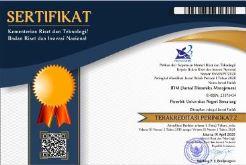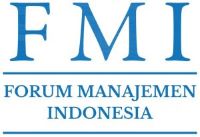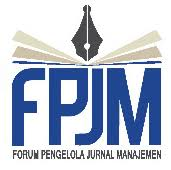Model of Relationship Marketing and E-Commerce in Improving Marketing Performance of Batik SMEs
Abstract
Keywords
Full Text:
PDFReferences
Ardyan, E. 2016. Market sensing capability and
SMEs performance: The mediating role of
product innovativeness success. Business &
Economics Review. 25 (2): 1-18.
Barney, J. B. 1991. Firm Resources and Sustained
Competitive Advantage. Journal
of Management, 17 (1): 99-120. doi:
1177/014920639101700108
Buttle, F. 2004. Customer Relationship Management:
Concept and Tool Elsevieer Worth Heineman.
Chien, S. Y & Tsai, C. H. 2012. Dynamic capability,
knowledge, learning, and firm performance.
Journal of Oranizational Change Management.
(3): 434-444.
Cohen, D & Prusak, L. 2001. In Good Company:
Naili Farida, et al. / Model of Relationship Marketing and E-Commerce in...
How Social Capital Makes Organizations
Work. Massachuset: Harvard Business
School Press.
Coleman, J. S. 1988. Social capital in the creation of
human capital. The American Journal of Sociology:
95-120.
De Wulf, K & Odekerken-Schroder, G. 2000. The
Influence Seller Relationship Orientation and
Buyer Relationship Process on Trust Commitment
and Behavioral Loyalty in a Consumer
Environment. Working Paper Series.
Farida, N. 2016. Determinants of marketing performance:
innovation, market capabilities and
marketing performance. Jurnal Dinamika
Manajemen. 7 (1): 59-65.
Ferdinand, A. 2000. Manajemen Pemasaran: Sebuah
pendekatan Strategik. Program Magister
Manajemen. Semarang: Badan Penerbit Universitas
Diponegoro.
Ferdinand, A. 2005. Modal Sosial dan Keunggulan Bersaing:
Wajah Strategi Pemasaran. Semarang:
Badan Penerbit Universitas Diponegoro.
Ghozali, I. 2008. Model Persamaan: Konsep dan Aplikasi
dengan Program AMOS 16. Semarang:
Badan Penerbit UNDIP.
Griffith, A., Noble, S. M & Chen, Q. 2006. The performance
implications of entrepreneurial
proclivity: A dynamic capabilities approach.
Journal of Retailing. 82 (1): 51-62.
Haroon, M & Kocak, A. 2011. The Relationship Between
Entrepreneurial Orientation Dynamic
Capabilities and Firm Performance: An Exploratory
Study of Small Turkish Firms. International
Journal of Business and Globalization.
(3): 351-366.
Ismail, T. 2015. Social capital and organizational
performance: Empirical study of Small to
Medium Sized Enterprises (SME) in Indonesia.
International Journal of Entrepreneurship.
: 60-73.
Kohli, A. K & Jaworski, B. J. 1990. Market Orientation:
The Construct,Research Propositions,
and Managerial Implications. Journal of Marketing.
(2): 1-18.
McDermott, C. M & Prajogo, D. I. 2012. Service
innovation and performance in SMEs. International
Journal of Operations & Production
Management. 32 (2): 216-237.
Narver, J. C & Slater, S. F. 1990. The effect of a market
orientation on business profitability. Journal
of Marketing. 54 (4): 20-35.
Nugroho, P. S & Setyawan, A. A. 2015. Permoderasian
Modal Sosial Pad Pengaruh Entrepreneur
Terhadap Peningkatan Kinerja Organisasi
(Studi Empiris pada UKM Di Surakarta. Benefit
Jurnal Manajemen dan Bisnis. 19 (1): 80-94.
Otero-Neira, C., Lindman, M. T & Fernandez, M.
J. 2009. Innovation and Performance in SME
Furniture Industries. Marketing Intelligence &
Planning. 27 (2): 216-232.
Pavlou, P. A & El Sawy, O. A. 2011. Understanding
the elusive Black Box of Dynamic Capabilities.
Decision Sciences. 42 (1): 239-273.
Power, D. 2005. Determinats of business-to-business
e-commerce implementation and performance
a structural model. Supply Chain
Management: An International Journal. 10
(2): 96-113.
Salwani, M. I., Marthandan, G., Norzaidi, M. D &
Chong, S. C. 2009. E-commerce usage and
business performance in the Malaysian tourism
sector: Empirical Research. Information
& Computer Security. 17 (2): 166-185.
Sok, P., O’cass, A & Sok, M. K. 2013. Achieving superior
SME performance: Overarching role
of marketing, innovation, and learning capabilities.
Australasian Marketing Journal. 21
(3): 161-167.
Syafruddin, C. 2003. Relationship Marketing: Inovasi
Pemasaran Yang Membuat Pelanggan
Bertekuk Lutut. Jakarta: PT. Gramedia Pustaka
Utama.
Tjiptono, F & Chandra, G. 2012. Pemasaran Strategik.
Yogyakarta: ANDI.
Voss, G. B & Voss, Z. G. 2000. Strategic Orientation
and Firm Performance in an Artistic Environment.
Journal of Marketing. 64 (1): 67-83.
Weerawardana, J. 2003. Exploring the role of market
learning capability in competitive strategy.
European Journal of Marketing. 37 (3/4):
-409. doi: 10.1108/03090560310459023
Wiklund, J. 1999. Sustainable of entrepreneurial orientation
performance relationship. Entrepreneurship
Theory and Practice. 24 (1): 37-48.
Yang, Z., Shi, Y & Yan, H. 2016. Analysis on pure ecommerce
congestion effect, productivity effect
and profitability in China. Socio-Economic
Planning Science, in Press, Corrected Proof.
Zheng, C., O’Neill, G & Maorrison, M. 2009. Enhancing
Chinese SME performance through
innovative HR practices. Personnel Review. 38
(2): 175-194.
View Counter: Abstract - 6912 and PDF - 4740
Refbacks
- There are currently no refbacks.





